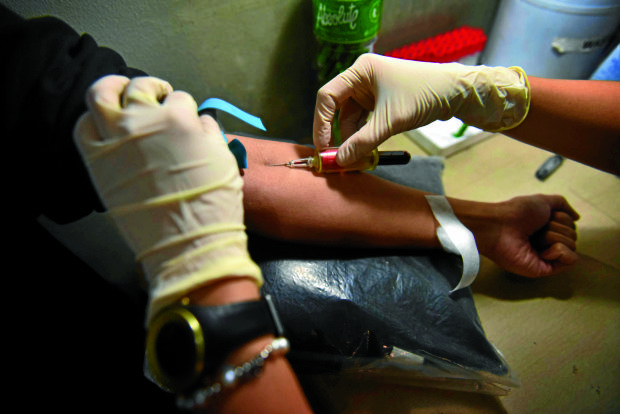Condom plan gets killed as HIV soars

LOVE YOURSELF Michael Jamias gets a regular HIV test at Love Yourself, a clinic in Manila where he serves as a volunteer.While the rate of new HIV infections has been falling across the Asia-Pacific region, it is soaring in the Philippines and moving beyond the population of young gay and bisexual men. —JES AZNAR/THENEWYORK TIMES
Jhay-ar Tumala remembers sitting in a pew at Manila’s Quiapo Church, holding a sealed envelope with his HIV test results, and praying. He was 19 and had been having sex since he was 15.
“I didn’t know anything about HIV or AIDS,” Tumala, 23, said last week. He does not remember reading about the deadly disease in the papers or learning about it in school. And he had used condoms only intermittently.
The envelope contained bad news.
Tumala’s story is not unusual, and that may also mean bad news for the Philippines.
While the rate of new HIV infections has been falling across the Asia-Pacific region in recent years, it has been soaring in the Philippines. The biggest increase is among gay or bisexual men under 25.
Article continues after this advertisement“The Philippines has the fastest-growing HIV infection rate in Asia, along with Afghanistan,” said Steven Kraus, director of UNAIDS, the United Nations HIV/AIDS agency, for Asia and the Pacific. “Right now, the Philippines runs the risk of letting the infection get out of control.”
Article continues after this advertisementBetween 2010 and 2015, aggressive awareness and prevention campaigns have led to a global decline in HIV infection rates.
In Asia, rates have decreased 5 percent. UNAIDS estimates significant decreases of more than 30 percent in neighboring Southeast Asian countries like Thailand, Cambodia and Malaysia.
New infections skyrocketing
While the total number of Filipinos living with HIV is low—about 39,600 in a country of more than 100 million—new infections are skyrocketing. UNAIDS estimated the rate of new infections has increased by more than 50 percent between 2010 and 2015.
The infection rate has been particularly explosive among gay men under 25 years, like Tumala. Among young people most at risk for HIV—gay men, injecting drug users, transgender women and female prostitutes—the rate of new infections has increased 230 percent between 2011 and 2015.
But the Philippines has been stymied in its efforts to raise awareness about the disease and to arrive at an effective strategy for preventing it among young people.
According to the Department of Health (DOH), only 17 percent of Filipinos between the ages of 15 and 24 understand what HIV is and how it spreads.
Last month, the Department of Education (DepEd) announced that it would scrap a plan developed by the DOH to distribute condoms to juniors and seniors in public high schools.
The plan would have trained teachers to counsel students on how to prevent pregnancies and sexually transmitted infections, and to offer voluntary HIV testing. It would have also provided training to help parents talk to their children about sex.
Plan opposed
The plan was opposed by a coalition of parents, the Roman Catholic Church and conservative politicians.
Sen. Vicente Sotto III said in an interview last month that distributing condoms in schools amounted to encouraging promiscuity.
The Rev. Jerome Secillano, an officer of the Catholic Bishops’ Conference of the Philippines, praised the decision to back away from the plan as “a wise move.”
About 80 percent of Filipinos are members of the Catholic Church, which advocates abstinence as the way to reduce HIV infections.
Dr. Jose Gerard Belimac, HIV and AIDS coordinator for the DOH, called the reversal “a lost opportunity.”
A 2015 survey by the DOH found that 57 percent of young gay men at risk for infection were high school or college students, and 67 percent of people living with HIV were between the ages of 15 and 24.
Huge gap in reaching people
While the DOH runs several anti-HIV programs, it faces a huge gap in reaching young people.
Filipinos under 18 are required by law to have parental consent to buy condoms, to get them from health centers or to get tested for HIV.
Laws limiting government distribution of contraceptives have hampered extensive condom distribution drives, a proven method of prevention.
“All good and successful national AIDS programs use condoms,” Kraus said.
Of the countries that have posted 30- to 35-percent reductions in new HIV infections, “a lot of those reductions have been the result of comprehensive condom programming,” he added.
Generational clash
Chris Lagman, director of learning and development at Love Yourself, a nongovernment HIV testing center he helped open in 2011, said the barrier to a more robust program came not just from Church teachings.
According to Lagman, there’s also the clash of generational values between younger Filipinos, who are growing up in a more permissive culture and experimenting with sex earlier, and their parents who, like the generations before them, are disinclined and ill equipped to discuss sexual health.
“That’s the perfect formula for sexually transmitted infections, including HIV,” he said. “The youth explore, but do it without the proper education.”
In addition, buying a condom can be a shameful experience. Younger people fear the humiliation of being carded. Getting tested for HIV provokes a similar response.
The long stretch of relatively low numbers of HIV infections in the Philippines has bred carelessness toward condom use that continues in the current epidemic.
Children as young as 2 and 3 years old, have reportedly tested positive for HIV, suggesting the infections are moving into the general population, which will make prevention an even more complex challenge. —NEW YORK TIMES NEWS SERVICE